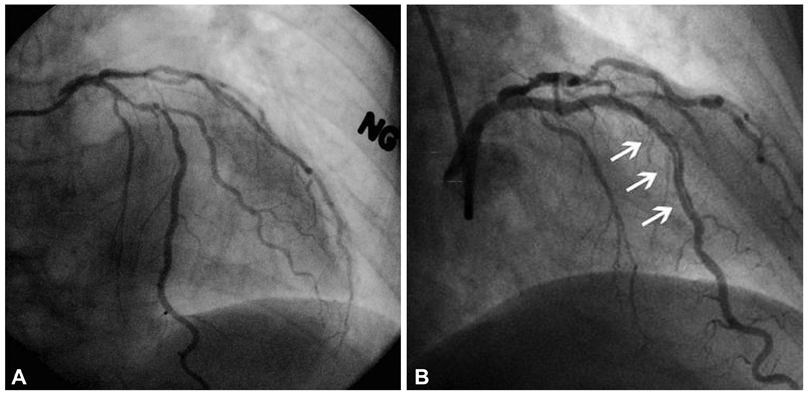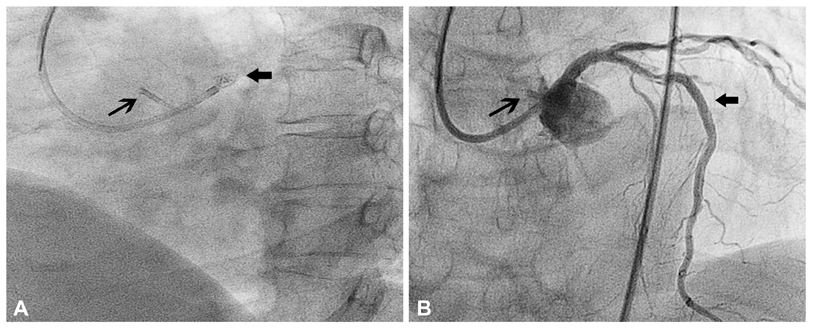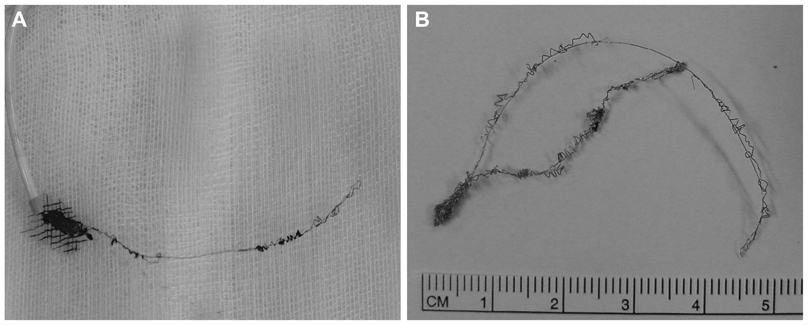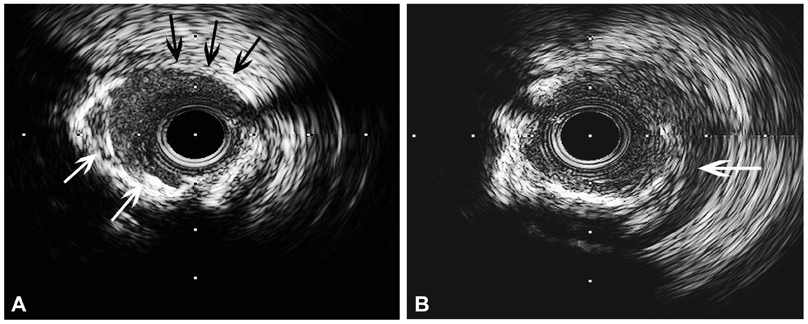Korean Circ J.
2012 Jul;42(7):492-496. 10.4070/kcj.2012.42.7.492.
Successful Retrieval of Intravascular Stent Remnants With a Combination of Rotational Atherectomy and a Gooseneck Snare
- Affiliations
-
- 1Division of Cardiology, Department of Internal Medicine, Han-Il General Hospital, Seoul, Korea.
- 2Division of Cardiology, Cardiac and Vascular Center, Samsung Medical Center, Sungkyunkwan University School of Medicine, Seoul, Korea. hcgwon@skku.edu
- KMID: 2094122
- DOI: http://doi.org/10.4070/kcj.2012.42.7.492
Abstract
- Stent migration from the delivery balloon catheter is a rare but serious complication during percutaneous coronary intervention, particularly when a part of the stent stretches into the aorta. We report an unusual case of stent migration treated with a combination of a gooseneck snare and rotablation. A part of the stent was overstretched and unrolled into the aorta and the rest of the stent remained implanted in the coronary artery. The stent was captured with a gooseneck snare but could not be retrieved because it was connected to a stent remnant implanted in the coronary artery. The stent strut was cut with rotablation, and the stent was successfully removed through the femoral sheath.
MeSH Terms
Figure
Cited by 1 articles
-
Re-mobilization of Lost Coronary Stent From the Axillary Artery to the Femoral Artery
Jeong Seok Lee, Hack-Lyoung Kim, Jae-Bin Seo, Woo-Hyun Lim, Eun Gyu Kang, Woo-Young Chung, Sang-Hyun Kim, Zoo-Hee Jo, Myung-A Kim
J Lipid Atheroscler. 2016;5(1):87-92. doi: 10.12997/jla.2016.5.1.87.
Reference
-
1. Eggebrecht H, Haude M, von Birgelen C, et al. Nonsurgical retrieval of embolized coronary stents. Catheter Cardiovasc Interv. 2000. 51:432–440.2. Alexiou K, Kappert U, Knaut M, Matschke K, Tugtekin SM. Entrapped coronary catheter remnants and stents: must they be surgically removed? Tex Heart Inst J. 2006. 33:139–142.3. Sheth R, Someshwar V, Warawdekar G. Percutaneous retrieval of misplaced intravascular foreign objects with the Dormia basket: an effective solution. Cardiovasc Intervent Radiol. 2007. 30:48–53.4. Reidemeister JC, Wolfhard U. Direct coronary bypass operation in complicated coronary dissection. Z Kardiol. 1996. 85:Suppl 1. 67–72.5. Capuano F, Simon C, Roscitano A, Sinatra R. Percutaneous transluminal coronary angioplasty hardware entrapment: guidewire entrapment. J Cardiovasc Med (Hagerstown). 2008. 9:1140–1141.6. Wolf F, Schernthaner RE, Dirisamer A, et al. Endovascular management of lost or misplaced intravascular objects: experiences of 12 years. Cardiovasc Intervent Radiol. 2008. 31:563–568.
- Full Text Links
- Actions
-
Cited
- CITED
-
- Close
- Share
- Similar articles
-
- Percutaneous Transluminal Retrieval of Catheter Foreign Body Using Loop-Snare Technique
- Successful coronary stent retrieval from the ascending aorta using a gooseneck snare kit
- Experience in High Speed Rotational Coronary Atherectomy
- Percutaneous Retrieval of an Intravascular Catheter Embolus
- Rotational Atherectomy: A to Z







